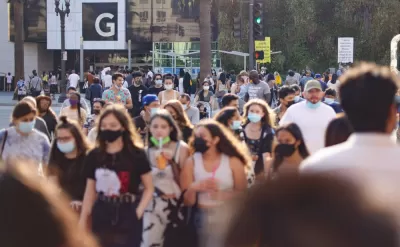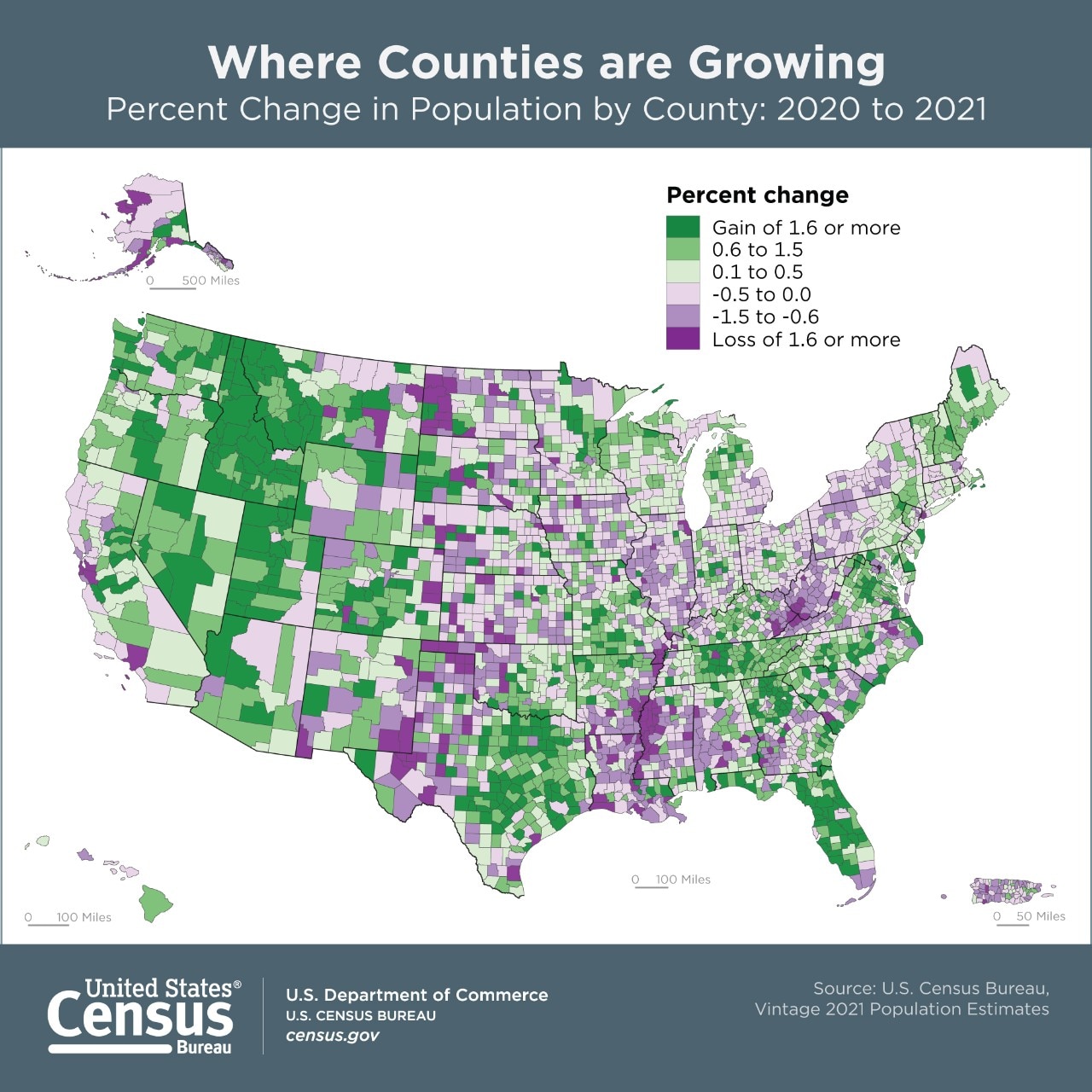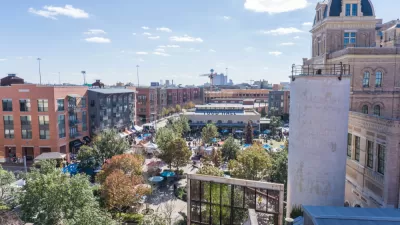The nation's three largest cities lost a combined 700,000 residents between July 2020 and July 2021—the fastest growing regions in the country couldn't keep up. The new data is being framed in the media as evidence of the decline of cities.

The U.S. Census Bureau released new population data on March 24, revealing unprecedented trends and a stark reversal from just ten years ago.
According to a press release announcing the Vintage 2021 population estimates, "More than 73% (2,297) of U.S. counties experienced natural decrease in 2021, up from 45.5% in 2019 and 55.5% in 2020."
"Natural decrease occurs when there are more deaths than births in a population over a given time period. In 2021, fewer births, an aging population and increased mortality – intensified by the COVID-19 pandemic--contributed to a rise in natural decrease," continues the press release.
Media coverage of the new census data was widely available on the day of the data drop, led by an article by Robert Gebeloff, Dana Goldstein, and Winnie Hu for the New York Times that headlined the country's overall slow rate of population growth and the decline of population in the nation's three largest cities—Los Angeles, New York, and Chicago—in addition to other superstar cities like San Francisco.
The article describes the trends evident in the Census data as complex enough to defy simple explanation:
The pandemic played a role, as the number of people dying rose substantially and many Americans left cities for smaller places. But experts say that skyrocketing housing costs were also to blame, and that some of the changes are a continuation of fundamental shifts in American demographics that began before the pandemic, such as the steadily falling birthrate and steep drop in immigration.
Here's how the New York Times article summarizes the geography of pandemic population trends:
New York, Los Angeles, Chicago and San Francisco lost a total of over 700,000 people from July 2020 to July 2021, according to the Census Bureau. Meanwhile, Phoenix, Houston, Dallas, Austin and Atlanta gained more than a total of 300,000 residents. And there was also substantial growth in some rural areas and smaller cities like Boise, Idaho, and Myrtle Beach, S.C.
Also, the New York Times presents the data as a reversal of the trend toward urban growth that defined much of the past decade since the Great recession:
The pattern is a notable contrast from a decade ago, when large cities were growing, bolstered by a decades-long boom in immigration and the rising popularity of urban living. At that time, most of the counties losing population were rural or experiencing economic decline.
Richard Florida took to Twitter to provide insight into the data, and the New York Times' coverage of the data, and noted that while the largest cities are losing the most residents, the next tier of large cities are gaining residents.
"To me the big takeaway of the this [sic] story on population is that growth is strongly concentrated in a group of pretty large metros like 6-7 million people large like Dallas, Houston & Atlanta as well as Phoenix and Austin," writes Florida on Twitter. "This should not be all that surprising, and it suggests "urbanization" is still at work. It is not small tiny places sucking up all the growth. It is the 2nd largest places outside of NY, LA and Chicago."
Another article by Mike Schneider for the Associated Press found its way into various local daily news sites. For the Chicago Tribune, Schneider's article is headlined by Chicago's population loss. For the Houston Chronicle, Schneider's article is headlined by Houston's population growth.
The University of North Carolina at Chapel Hill also provides insight into the new Census data specific to that state's growth. "North Carolina grew by 112,000 people or 1.1% between April 1, 2020, and July 1, 2021, faster than the national rate of 0.1%. According to the estimates, 73 North Carolina counties grew in the 15 months following the Census," according to the article by Rebecca Tippett.
FULL STORY: Over Two-Thirds of the Nation’s Counties Had Natural Decrease in 2021

Alabama: Trump Terminates Settlements for Black Communities Harmed By Raw Sewage
Trump deemed the landmark civil rights agreement “illegal DEI and environmental justice policy.”

Planetizen Federal Action Tracker
A weekly monitor of how Trump’s orders and actions are impacting planners and planning in America.

Why Should We Subsidize Public Transportation?
Many public transit agencies face financial stress due to rising costs, declining fare revenue, and declining subsidies. Transit advocates must provide a strong business case for increasing public transit funding.

Understanding Road Diets
An explainer from Momentum highlights the advantages of reducing vehicle lanes in favor of more bike, transit, and pedestrian infrastructure.

New California Law Regulates Warehouse Pollution
A new law tightens building and emissions regulations for large distribution warehouses to mitigate air pollution and traffic in surrounding communities.

Phoenix Announces Opening Date for Light Rail Extension
The South Central extension will connect South Phoenix to downtown and other major hubs starting on June 7.
Urban Design for Planners 1: Software Tools
This six-course series explores essential urban design concepts using open source software and equips planners with the tools they need to participate fully in the urban design process.
Planning for Universal Design
Learn the tools for implementing Universal Design in planning regulations.
Caltrans
Smith Gee Studio
Institute for Housing and Urban Development Studies (IHS)
City of Grandview
Harvard GSD Executive Education
Toledo-Lucas County Plan Commissions
Salt Lake City
NYU Wagner Graduate School of Public Service






























